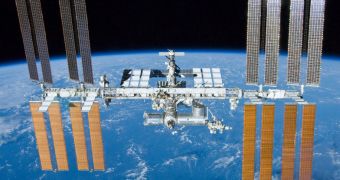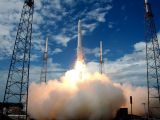For the past decade or so, governments around the world have been working together on building the International Space Station (ISS), a science facility meant to boost cooperation and to advance space studies. But many voices call for the next step, the construction of a structure dedicated to space exploration.
I personally believe that the time is ripe for this to happen. Maybe not starting next year, but definitely in the coming decade. The ISS has been used extensively as a test bed for new technologies, but it does have its limitations in terms of what can be accomplished.
Frankly speaking, it's becoming obvious that the space industry is a lot more complex and well-developed now than it was in 1997, when several space agencies decided to tread on the path set by the Russian MIR space station.
They did so at great expense – an estimated $100 billion – but they proved that building a highly-advanced orbital facility is possible. Perhaps it's now time to take that endeavor one step forward, and construct something like an assembly facility.
Just think about it, how cool would it be to have a place in low-Earth orbit (LEO) where various components of a larger spacecraft can be assembled, after being delivered individually from the ground.
The advantages associated with this would be tremendous. Perhaps the largest one would be that countless engineering issues associated with developing a large spacecraft on Earth would be circumvented. The sheer size of the fuel tanks that would be required to get such a ship out of the atmosphere make it impossible to build.
But navigating through space requires a lot less chemical propellants, of the type modern delivery systems and related boosters use. Launching individual spacecraft components to an ISS-like assembly plant in space would make it a lot easier to design the actual ship in a manner that focuses entirely on space travel.
Another reason why this will become cheaper in the near future is the large amount of competition that is currently developing on the space market. Space agencies no longer have monopoly over this field, and private companies are beginning to come up with their own designs.
These rockets are a lot cheaper and more efficient than the ones we were accustomed to until now, because there corporations are driven by the principles of market economy, which calls for delivery systems to be profitable.
For example, Orbital Science Corporation is developing the Minotaur 4 rocket and the Taurus II delivery system. The latter will be used in the coming years in conjunction with the Cygnus spacecraft, for conducting unmanned resupply missions to the ISS.
Hawthorne, California-based Space Exploration Technologies Corporation (SpaceX) is also developing the Dragon space capsule and the Falcon rocket series. The boosters can be developed into many variants, some of which may become heavy-lift delivery systems.
Other companies are working on developing similar rockets, and all of them want to be able to reach LEO. Competition will force launch prices down, and so using them for delivering components for a future, larger spacecraft to space could become feasible.
This is only speculation, but say you split up the future ship into ten basic components. Ten rocket launches would be required to deliver all of them to space, and the costs associated with this could be between $1 and $3 billion.
These figures are based on the fact that launching a space shuttle costs about $450 million per mission. If Project Constellation were to continue, NASA estimated that launch costs could have dropped to $138 million per flight.
So assuming that launching a privately-built rocket costs between $100 and $300 million per flight, you would end up with the aforementioned price tag for delivering all components to the assembly facility.
Naturally, actually launching them will not make up for the largest part of costs associated with such an endeavor. Most of the money will be spent on research&development of new technologies, and on actually constructing the components. Additional funds will go to building the ISS-like structure.
But the thing about the orbital assembly plant is that it will cost a lot less than the space station, because it will not have to contain science modules and such vast arrays of solar panels. Three modules would be sufficient to accommodate a small crew.
The astronauts would then proceed to assemble the delivered components via the use of dexterous robotic arms, similar to the Canadarm-2 currently in use on the ISS. The entire assembly process could be directed from structures similar to the Cupola dome installed on the ISS.
Once the spacecraft would be completed, the crews that will man it, and take it for a cosmic joyride would ride a space capsule directly to the spacecraft, where they will attach their vehicle to a docking berth.
The large spacecraft could then fly away towards other planets, or moons, and the assembly facility would be open to start constructing a new one. Although no one can say for sure how expensive such an endeavor would be, I strongly believe that the costs will not exceed the $100 billion price tag of the ISS.
But, before this can be attempted, a series of experiments still need to be conducted, and a host of technologies developed further. Scientists still need to determine how cosmic radiation influence crews, and develop radiation shields accordingly.
Research into this is ongoing, and it will probably not take long before a positive result is achieved. Then, healthcare experts need to address the psychological and physical impacts of prolonged exposure to microgravity in a small community. The Mars500 experiment, underway in Russia, is testing some of these aspects.
One positive effect of assembling a larger spacecraft in LEO would be that less compartments would be dedicated to carrying fuel. This means that life support systems could be extended, and more astronauts accommodated per mission.
On the technical side of the argument, I believe that an efficient propulsion system is the main thing that separates humankind from real space exploration. Given the vastness of distances in space, a crew cannot afford to waste decades until they reach Pluto, or other Kuiper Belt Objects (KBO).
Advancements in biotechnology have already produced the means to support such an endeavor. Artificial greenhouses and plants that grow in water alone are now a reality, so astronauts will no longer have to consume canned foods alone.
On the bright side of things, the heads of space agencies have already discussed such a plan in principle, but centered around the ISS. That can work as well, even if the current position of the docking berths is not the most fortunate in terms of attaching bulky objects to them.
It remains to be seen whether a plan for an orbital assembly facility will be approved, but I have no doubt in my mind that this is what we're heading for. Within the next decades, I am convinced that we will see things being built that we can't even imagine at this point.

 14 DAY TRIAL //
14 DAY TRIAL // 

